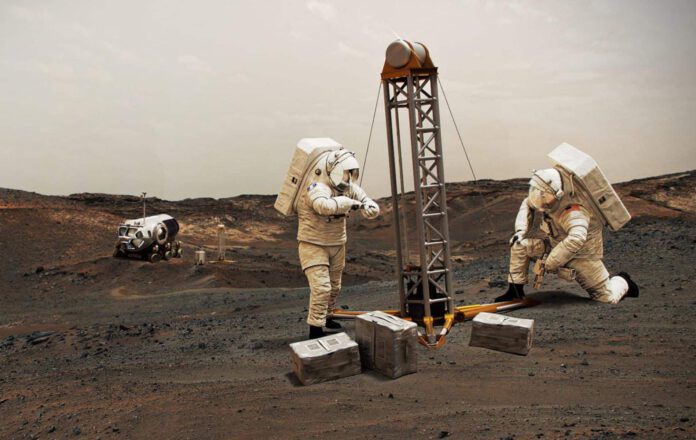
Planning for Mars Colonization
The discovery of large amounts of water on Mars reduces the need for transporting water from Earth. Reducing this requirement marks a significant step toward the colonization of our neighboring planet.
Water Resources for Future Mars Settlers
Water is an essential resource on Mars that will serve several uses like providing drinking water, food preparation, and even as a critical ingredient for rocket fuel. The discovery of water on Mars is key to planning and enabling human colonization. It would not be feasible in the long run to rely solely on resources transported from Earth. Fortunately, technology has made identifying water sources more manageable.
The Search for Water on Mars
Today, Mars is dry and barren, but it does have water sources, not as free-flowing water, but as ice. Mars’ thin atmosphere leads to water evaporating rapidly. Most water on Mars is in the form of polar ice caps, not an ideal location for future Mars settlers due to the extreme cold. However, there’s another option—subterranean ice. Scientists learned from previous missions that underground ice exists on Mars, and this could be incredibly valuable for future manned Mars missions.
Locating Underground Water: The Subsurface Water Ice Mapping Project
The pressing question remains: where exactly can we find this underground ice? This question is being addressed through a NASA-funded project called ‘Subsurface Water Ice Mapping’ (SWIM). SWIM recently released its fourth set of maps, the most detailed to date since launching the project in 2017.
The Most Detailed Water Map To Date
SWIM combines information from multiple NASA missions, including the Mars Reconnaissance Orbiter (MRO), the 2001 Mars Odyssey, and the now-defunct Mars Global Surveyor, resulting in the best map yet revealing the water sources on Mars. Scientists used higher resolution cameras on the MRO to provide much more precise information about the presence and exact locations of Mars’ underground ice.
Mars’ Equator and Suitable Landing Sites
Research findings show that Mars’ underground ice mainly concentrates in the mid-latitudes, particularly the northern mid-latitudes. This region has a significantly thicker atmosphere than most other parts of the planet, making it ideal for slowing down spacecraft during landing. Ideal landing sites would be along the southern border of this region, both close to the ice and near the equator, where temperatures are more hospitable.
Sydney Do, the SWIM project manager, said, “When sending humans to Mars, you want to get them as close to the equator as possible. That means less energy is spent keeping astronauts and their equipment warm, and more energy is available for essential needs.”
Determining Mars’ First Landing Site
The advanced new map could help NASA decide where the first astronauts on Mars should land, ideally where there is ample water. If astronauts have access to a larger amount of water, the need to transport water from Earth could be greatly reduced.
Serving a Scientific Purpose
While the map provides practical benefits, it also serves a vital scientific purpose. In the future, astronauts or robots might be able to drill for ice cores, similar to what scientists do on Earth. This could provide additional insight into Mars’ climatic history.
Nathaniel Putzig, a researcher involved in the project, stated that “It could help scientists refine their models that attempt to explain how Mars’ climate has changed in the past. It might even reveal potentially suitable habitats (both past and present) for microbial life.” Furthermore, the map could also unravel other mysteries and unresolved questions about Mars.
Mars Colonization Progress
The study brings us one step closer to Mars colonization, although there is a long journey ahead. The researchers hope their project will serve as a foundation for the proposed Mars Ice Mapper mission—a satellite with an advanced radar designed to better search for ice beneath the surface. The current plan is to launch this mission in 2026.











